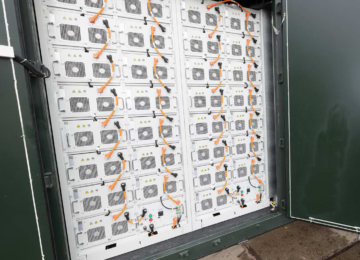Spring Memorandum: cabinet asks ACM to look at room to cut rates on batteries
Minister Hermans presented the Spring Memorandum last week. The Spring Memorandum contains additional announced climate measures that were taken partly on the basis of the IBO Financing Electricity Infrastructure. In his appreciation of the IBO, the minister discusses the steering of opslag locations and net rates for energy storage.
Control of storage locations
In response to the IBO report, Minister Hermans indicated that for a future-proof energy system, both electrolysis capacity and battery technologies are essential for energy storage and grid stability. The government shares the conclusion that here, too, targeted location control can help limit additional investments in the electricity grid. It is important that energy demand, supply, transmission, flexibility and conversion be developed in conjunction, including in the use of space. Control of land and in some cases the provision of land can help in this regard.
It is for this reason that the Cabinet, together with TenneT and the regional grid operators, is mapping out suitable storage locations as accurately as possible. The Lower House will be informed about this at the end of this year, in accordance with the Grinwis motion adopted earlier.
It also indicated that, should the tariff system and spatial instruments offer insufficient incentives to achieve the desired location control, the government will examine whether it can use subsidy conditions to steer the realization of electrolysis capacity and batteries at locations with low social costs..
Energy Storage NL is pleased that the government is listening to the need from the sector to form a proactive view on locations for energy storage. Currently, there is much uncertainty about suitable storage sites for both the market and provinces and municipalities, unnecessarily inhibiting the development of storage projects. Looking at location steering, ESNL indicates that careful consideration should be given to the processing of storage applications already submitted and how they can proceed pending this framework. In addition, to make location steering attractive, ESNL indicates that the reservation of necessary land positions (including necessary preconditions such as permits) for storage projects should also be considered.
Net energy storage rates
Current grid tariffs remain a major problem for the rollout of storage projects. The minister reported that the cabinet is in regular discussions with the ACM about the grid tariff structure and how it affects the Dutch energy market and impacts energy and climate goals.
In that context, the cabinet will also ask ACM whether it sees room within European frameworks to reduce network tariffs for electrolysis and battery storage. This may be, for example, in light of the integration of renewable energy and security of supply, the facilitation of energy storage and the achievement of the objectives of integrated national energy and climate plans. The minister indicates, however, that it remains up to the ACM to assess whether and to what extent it considers special treatment of batteries and electrolysers desirable and defensible within European rules, while also respecting the principles of cost reflectivity, transparency and non-discrimination.
In addition, the minister indicates that the ACM will publish a draft decision for an import tariff in 2025. In accordance with the motion of members Grinwis and Bontenbal of March 6 last. the ACM will also be asked to include the role of storage in an input tariff in the draft decision. The ACM has indicated to the Cabinet that it is sympathetic to this.
Energy Storage NL appreciates the government's announced commitment to ask the ACM whether there is additional room to reduce network tariffs for battery storage, among other things. In doing so, ESNL indicates that this space is already offered by the European Commission based on EU Regulation 2019/943 and Directive 2019/944, and is even urged to do so. For example, Regulation 2019/943 Article 3 stipulates that generation, energy storage and demand response participate in the market on an equal footing (are thus all market participants), that market rules used by member states should ensure that these market participants can be used efficiently and that they have a right to access transmission and distribution networks under objective, transparent and non-discriminatory conditions.
In the current Dutch tariff code, energy storage is de facto not seen as the market participant it actually is, but equated with consumers. That energy storage should not be seen as a consumer is also made clear in EU Directive 2019/944, which states that with electricity storage the consumption of the electrical energy (by a final consumer) is actually deferred. It is also for this reason that countries such as Belgium, Germany, Spain and UK do use this space to assess storage differently in tariff systems and thus approach storage differently than the Netherlands. ESNL points out that this leads to a growing uneven playing field and calls on the ACM to address this.





